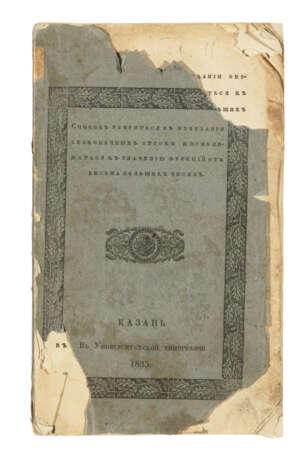ID 381309
Lot 101 | Nicolai Ivanovich Lobachevsky (1792-1856)
Valeur estimée
£ 15 000 – 20 000
First edition, exceptionally rare offprint, of this important essay on the foundations of calculus and real analysis by the first inventor of non-euclidean geometry. ‘As early as 1835, Lobachevsky showed in a memoir [the offered work] the necessity of distinguishing between continuity and differentiability’ (Cajori, History of Mathematics, p. 421). This paper was published in the Scientific Memoirs of Kazan University, 1835, No. 2, pp. 211-342.
Lobachevsky’s works in other areas of mathematics were either directly relevant to his geometry (as his calculations on definite integrals and probable errors of observation) or results of his studies of foundations of mathematics (as his works on the theory of finites and the theory of trigonometric series). ‘The mathematicians of the eighteenth century did not touch the question of the relation between continuity and differentiability, presuming silently that every continuous function is eo ipso a function having a derivative. Ampère tried to prove this position, but his proof lacked cogency. The question about the relation between continuity and differentiability awoke general attention between 1870 and 1880, when Weierstrass gave an example of a function continuous within a certain interval and at the same time having no definite derivative within this interval (non-differentiable). Meanwhile, Lobachevski already in the thirties showed the necessity of distinguishing the ‘changing gradually’ (in our terminology: continuity) of a function and its ‘unbrokeness’ (now: differentiability). With especial precision did he formulate this difference in his Russian Memoir of 1835: ‘A method for ascertaining the convergence, etc.’ [the paper we offer here]. A function changes gradually when its increment diminishes to zero together with the increment of the independent variable. A function is unbroken if the ratio of these two increments, as they diminish, goes over insensibly into a new function, which consequently will be a differential-coefficient. Integrals must always be so divided into intervals that the elements under each integral sign always change gradually and remain unbroken’ (Halsted, p. 242). This work includes an extensive discussion of infinite series, including a new convergence criterion, now known as ‘Lobachevsky’s test’. Much space is also devoted in this memoir to definite integrals, prompted by the computation of areas and volumes in Lobachevskian geometry. One year later, Lobachevsky devoted a whole memoir to this subject. The Kazan publications of Lobachevsky are exceptionally rare, even in Russian collections. OCLC lists the Harvard copy only. Halsted, ‘Biology and Mathematics,’ Twelfth Annual Report of the Ohio State Academy of Science, 1903, pp. 239-47.
Octavo (230 x 142mm). Original printed wrappers with printed title enclosed in decorative border (wrappers damaged with partial loss of border, though not affecting text, first few leaves chipped at corners).
234 x 144 x 6 mm.
| Adresse de l'enchère |
CHRISTIE'S 8 King Street, St. James's SW1Y 6QT London Royaume-Uni | |
|---|---|---|
| Aperçu |
| |
| Téléphone | +44 (0)20 7839 9060 | |
| Commission | see on Website | |
| Conditions d'utilisation | Conditions d'utilisation |



